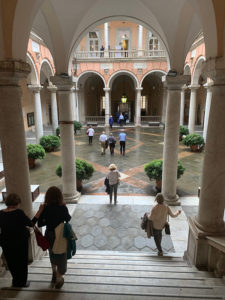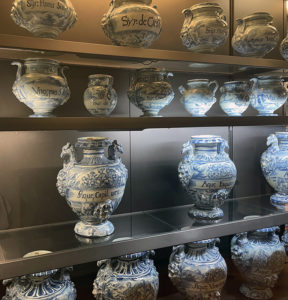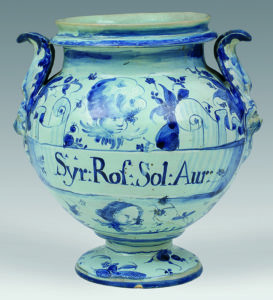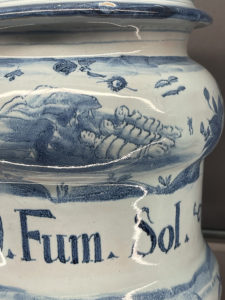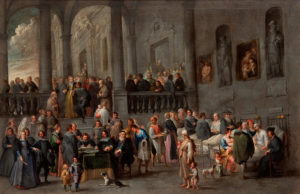Ceramics of Compassion: Palazzo Tursi’s Genoese Maiolica
EVENTS > STUDY TRIPS ABROAD
STUDY TRIP ABROAD FALL 2021 IN REVIEW
by Carrie Greif
While visiting Genoa during the Trust’s Fall Study Trip Abroad, we took in thousands of incredible objects, but a collection of pharmaceutical vessels arrested my attention. On the second floor of Palazzo Tursi (figure 1) in Genoa’s famed Strada Nuova district, one passes through a remarkable gallery that features floor-to-ceiling cases filled with blue and white Genoese ceramics (figures 2 and 3).
The pottery tradition in Liguria, a crescent-shaped section of Northwest Italy that borders the Mediterranean and encompasses Genoa, has ancient origins due to the presence of clay in the Ligurian basin. Archaeologists have been excavating in the region for over 40 years and have uncovered ceramic fragments with lead and tin-opacified lead glazing, indicating that the production of maiolica (tin-glazed earthenware) originated c. 1200. Interestingly, excavations have found that tin-glazing began in Southern Italy shortly after this date. Therefore, Liguria likely had a significant influence on the start of Italian maiolica production along with ceramics imported from North Africa into Sicily and Southern Italy.
Ceramics aficionados will note that bi-chromatic, blue and white ornament is fairly common in 16th-century ceramics. However, most Italian maiolica of that era, particularly the forms collected within American museum collections, feature bold colors and were inspired largely by Classical motifs. Genoese potteries instead relied almost exclusively on blue and white decoration, in imitation of contemporaneous Asian counterparts, either Ming porcelain or Turkish Iznikware.
Much cheaper than Eastern counterparts, Genoese maiolica flooded the market worldwide. Exported to Northern Europe, by 1550 Genoese maiolica was also largely sold to Spain and then on to America. The prominence of Genoese maiolica coincided with the rise of Genoa’s influence in Spain. In the mid-16th century, Genoese bankers repeatedly rescued the financially troubled Spanish monarchs, and Ligurians formed close connections throughout the Iberian Peninsula. Archaeological excavations in Mexico have unearthed a considerable quantity of Genoese pottery along with the late 16th-century Ming porcelains that were its inspiration.
Palazzo Tursi’s collections of Genoese maiolica are from two historic hospitals, the Pammatone and the Incurabili, both established in the Piccapietra district of eastern Genoa, an area that was bombed heavily during World War II, leaving neither building intact. The collection is the most complete holding of Italian pharmaceutical ceramic art in the world, and some objects are exhibited on the original wooden shelves, arranged to evoke the overall setting when in use in the 16th century.
Storage vessels were among the most frequently produced maiolica wares in late-Medieval and Renaissance Italy. The shapes were fairly standardized, with handles that fit into the vessel’s profile so that dozens could sit side by side on a pharmacy or shop shelf, as they are displayed in the museum. Another common feature includes inscriptions indicating the contents, a feature that began to appear in the 15th century as maiolica production in Genoa began to peak.
Known locally in Italian as porcelletta or “little porcelain,” Genoese maiolica claimed a strong connection with its superior Chinese prototype. However, the craft was also rooted in local production and tradition. Marta Ajmar-Wollheim and Luca Mola note that: “The term ‘porcelletta’ is striking because it is close to the more common ‘porcellana,’ porcelain, but it is a diminutive expression, almost a term of endearment evoking familiarity.”1 These vessels were not just imitations of foreign objects but wares that were adopted, designed, and localized.
The character of Genoese maiolica is expressed on the body of the pharmaceutical vessels, which are fairly uniform in scale and shape with ornamental borders. On closer observation, an entire case of ceramics at Palazzo Tursi contains vessels with three swaddled children depicted on the upper body of the vessels (figure 4). This ornament is indicative of vessels created for the Pammatone Hospital (figure 5), and the children are a reference for whom the medicine was intended. The Pammatone Hospital was the largest and oldest general hospital in Genoa, founded in 1423 by Bartolomeo Bosco specifically to treat women and children. Hospitals in Renaissance Italy primarily served as charitable institutions. The Catholic church, as well as the aristocracy, funded hospitals as a charitable act to serve the common good. Vessels like these give voice to a population that could be overlooked.
Having long been struck by the romance of Italian ceramics, like Bella Donna plates with ornamental references to loved ones and Renaissance maiolica with colorful depictions of Classical stories and motifs, I find something particularly compelling about the power of seemingly innocuous, utilitarian objects. The use of handcrafted details to cultivate a deeper sense of care feels uniquely Italian and especially characteristic of the decorative arts.
1. Ajmar-Wollheim, Marta, and Luca Mola. “The Global Renaissance: Cross-Cultural Objects in the Early Modern Period.” In Global Design History, edited by Glenn Adamson, Giorgio Riello, and Sarah Teasley, 11-19. (London: Taylor & Francis Ltd, 2011).
Carrie Greif is the Curator of Educational Programs for the Decorative Arts Trust.
A print version of this article was published in The Magazine of the Decorative Arts Trust, one of our most popular member benefits. Join today!
Complete a digital puzzle from this trip on our Puzzles webpage!

